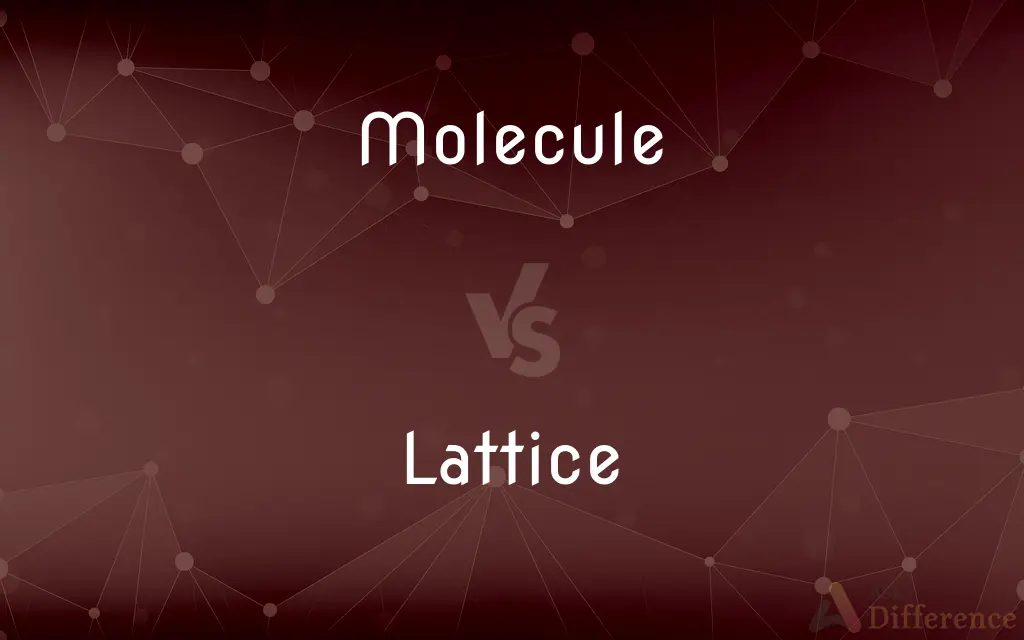Molecule vs. Lattice — What's the Difference?
Edited by Tayyaba Rehman — By Fiza Rafique — Updated on September 28, 2023
A molecule is the smallest unit of a chemical compound with distinct chemical properties, while a lattice is a three-dimensional arrangement of atoms, ions, or molecules in a crystal structure.

Difference Between Molecule and Lattice
Table of Contents
ADVERTISEMENT
Key Differences
Molecule refers to the smallest particle of a chemical compound that retains the distinct chemical properties of that compound. It consists of two or more atoms bonded together. Lattice, on the other hand, refers to a three-dimensional, repeating arrangement of atoms, ions, or molecules in a crystalline solid. It is a characteristic feature of crystals, where the constituent particles are arranged in a highly ordered and repetitive pattern.
Comparison Chart
Definition
Smallest unit of a chemical compound
Three-dimensional arrangement in a crystal
Composition
Composed of atoms or ions bonded together
Consists of repeating unit cells
Nature
Retains distinct chemical properties
Exhibits regular and ordered arrangement
Examples
Water (H2O), Oxygen (O2), and more
Salt (NaCl), Diamond (C), and others
ADVERTISEMENT
Field of Study
Chemistry
Solid-state physics and materials science
Compare with Definitions
Molecule
A molecule is the smallest unit of a chemical compound.
A water molecule consists of two hydrogen atoms and one oxygen atom.
Lattice
A lattice is a three-dimensional arrangement of particles in a highly ordered and repetitive pattern.
The crystal lattice of a diamond gives it its exceptional hardness.
Molecule
Molecules are held together by chemical bonds like covalent and ionic bonds.
In a water molecule, hydrogen atoms are covalently bonded to oxygen.
Lattice
Lattices are studied extensively in solid-state physics to understand the behavior of solids.
The band structure of semiconductors is determined by their lattice.
Molecule
Molecules retain the chemical properties of the compounds they belong to.
The unique chemical properties of methane (CH4) make it a natural gas.
Lattice
Lattices are characterized by the repetition of unit cells, giving rise to macroscopic crystal shapes.
The hexagonal lattice of a snowflake influences its symmetry.
Molecule
Molecules are fundamental to the study of chemistry, serving as the basic units of matter.
Molecular biology explores the role of molecules in living organisms.
Lattice
It is a defining feature of crystalline solids, where unit cells are repeated in all directions.
The lattice of table salt (NaCl) forms cube-shaped crystals.
Molecule
A molecule is an electrically neutral group of two or more atoms held together by chemical bonds. Molecules are distinguished from ions by their lack of electrical charge.
Lattice
Lattices play a crucial role in materials science, influencing material properties.
The lattice structure of metals affects their conductivity.
Molecule
The smallest particle of a substance that retains the chemical and physical properties of the substance and is composed of two or more atoms; a group of like or different atoms held together by chemical forces.
Lattice
An open framework made of strips of metal, wood, or similar material overlapped or overlaid in a regular, usually crisscross pattern.
Molecule
A small particle; a tiny bit.
Lattice
A structure, such as a window, screen, or trellis, made of or containing such a framework.
Molecule
(chemistry) The smallest particle of a specific element or compound that retains the chemical properties of that element or compound; two or more atoms held together by chemical bonds.
Hydrogen chloride is a diatomic molecule, consisting of a hydrogen atom and a chlorine atom.
Lattice
Something, such as a decorative motif or heraldic bearing, that resembles an open, patterned framework.
Molecule
A tiny amount.
Lattice
A regular, periodic configuration of points, particles, or objects throughout an area or a space, especially the arrangement of ions or molecules in a crystalline solid.
Molecule
One of the very small invisible particles of which all ordinary matter is supposed to consist.
Lattice
The spatial arrangement of fissionable and nonfissionable materials in a nuclear reactor.
Molecule
The smallest part of any substance which possesses the characteristic properties and qualities of that substance, and which can exist alone in a free state.
Lattice
To construct or furnish with a lattice or latticework.
Molecule
A group of atoms so united and combined by chemical affinity that they form a complete, integrated whole, being the smallest portion of any particular compound that can exist in a free state; as, a molecule of water consists of two atoms of hydrogen and one of oxygen. Cf. Atom.
Lattice
A flat panel constructed with widely-spaced crossed thin strips of wood or other material, commonly used as a garden trellis.
Molecule
(physics and chemistry) the simplest structural unit of an element or compound
Lattice
(heraldry) A bearing with vertical and horizontal bands that cross each other.
Molecule
(nontechnical usage) a tiny piece of anything
Lattice
(crystallography) A regular spacing or arrangement of geometric points, often decorated with a motif.
Molecule
Molecules can be composed of the same or different elements.
Carbon dioxide (CO2) is a molecule made up of carbon and oxygen atoms.
Lattice
(group theory) A discrete subgroup of Rn which is isomorphic to Zn (considered as an additive group) and spans the real vector space Rn.
Lattice
(music) A model of the tuning relationships of a just intonation system, comprising an array of points in a periodic multidimensional pattern.
Lattice
A discrete subgroup L of a given locally compact group G whose quotient space G/L has finite invariant measure.
Lattice
A partially ordered set in which every pair of elements has a unique supremum and a unique infimum.
Lattice
To make a lattice of.
To lattice timbers
Lattice
To close, as an opening, with latticework; to furnish with a lattice.
To lattice a window
Lattice
Any work of wood, metal, plastic, or other solid material, made by crossing a series of parallel laths, or thin strips, with another series at a diagonal angle, and forming a network with openings between the strips; as, the lattice of a window; - called also latticework.
The mother of Sisera looked out at a window, and cried through the lattice.
Lattice
The representation of a piece of latticework used as a bearing, the bands being vertical and horizontal.
Lattice
The arrangement of atoms or molecules in a crystal, represented as a repeating arrangement of points in space, each point representing the location of an atom or molecule; called also crystal lattice and space lattice.
Lattice
To make a lattice of; as, to lattice timbers.
Lattice
To close, as an opening, with latticework; to furnish with a lattice; as, to lattice a window.
Therein it seemeth he [Alexander] hath latticed up Cæsar.
Lattice
An arrangement of points or particles or objects in a regular periodic pattern in 2 or 3 dimensions
Lattice
Small opening (like a window in a door) through which business can be transacted
Lattice
Framework consisting of an ornamental design made of strips of wood or metal
Common Curiosities
What is a molecule?
A molecule is the smallest unit of a chemical compound that retains its distinct chemical properties.
Why are molecules important in chemistry?
Molecules are fundamental to the study of chemistry as they represent the building blocks of matter and compounds.
How are molecules formed?
Molecules are formed when atoms combine through chemical bonds, such as covalent and ionic bonds.
Do all molecules contain different elements?
No, molecules can be composed of atoms of the same element (diatomic molecules) or different elements.
What determines the shape of crystals in lattice structures?
The arrangement of unit cells in the lattice determines the shape of crystals in crystalline solids.
Give an example of a substance with a lattice structure.
Table salt (sodium chloride, NaCl) has a lattice structure that forms cube-shaped crystals.
Why is the study of lattices important in materials science?
Lattices influence the properties of materials, such as their conductivity, strength, and optical characteristics.
What is a lattice in a crystalline solid?
A lattice is a three-dimensional arrangement of atoms, ions, or molecules in a highly ordered and repetitive pattern within a crystalline solid.
Give an example of a common molecule.
Water (H2O) is a common molecule composed of two hydrogen atoms and one oxygen atom.
What is the significance of lattice structures in solid-state physics?
Lattice structures play a key role in understanding the behavior of solids, including semiconductors and superconductors.
Share Your Discovery

Previous Comparison
Academics vs. Academia
Next Comparison
Drive vs. StriveAuthor Spotlight
Written by
Fiza RafiqueFiza Rafique is a skilled content writer at AskDifference.com, where she meticulously refines and enhances written pieces. Drawing from her vast editorial expertise, Fiza ensures clarity, accuracy, and precision in every article. Passionate about language, she continually seeks to elevate the quality of content for readers worldwide.
Edited by
Tayyaba RehmanTayyaba Rehman is a distinguished writer, currently serving as a primary contributor to askdifference.com. As a researcher in semantics and etymology, Tayyaba's passion for the complexity of languages and their distinctions has found a perfect home on the platform. Tayyaba delves into the intricacies of language, distinguishing between commonly confused words and phrases, thereby providing clarity for readers worldwide.
















































